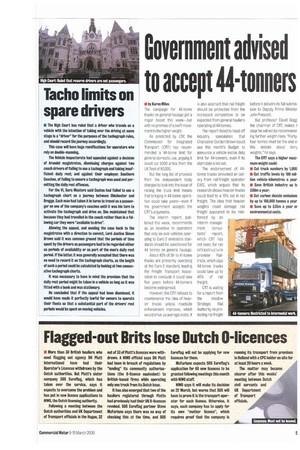Government advised to accept 44-tonners
Page 7

If you've noticed an error in this article please click here to report it so we can fix it.
• by Karat nes The campaign for 94-tonne trucks on general haulage got a major boost this week—but with no promise of a swift movement to the higher weight.
As predicted by CM, the Commission for Integrated Transport (CflT) has recommended a 44-tonne limit for general domestic use, arguing it Gould cut 1,000 antics from the UK fleet of 80,000.
But the long list of provisos from the independent body charged to look into the issue of raising the truck limit means that bringng in 44-tonne operation could take years—even if the government accepts the Ctrs arguments.
The interim report, published this week, recommends as an incentive to operators that only six-axle vehicles operating to Euro-2 emissions standards should be sanctioned for 44 tonnes on general haulage.
About 40% of 38to 41-tonne trucks are presently operating at the Euro-2 standard, leading the Freight Transport Association to conclude it could take five years before 44-tanners become widespread.
However, the CflT refuses to countenance the idea of heavier trucks unless roadside enforcement improves, which would drive up average costs. It is also adamant that rail freight should be protected from the increased competition to be expected from general hauliers operating at 44 tonnes.
The report failed to head off industry speculation that Chancellor Gordon Brown could use this month's Budget to announce a vehicle excise duty limit for 44-tonners, even if its start date is not set.
The endorsement of 44tonne trucks provoked an outcry from rail-freight operator EWS, which argues that its research shows heavier trucks could lead to a 19% cut in rail freight. The idea that heavier weights could damage rail freight appeared to be reinforced by an interim manage
ment consultants' report, which Cf1T has not seen, for rail infrastructure provider Railtrack, which says 44-tonne trucks could take up to 90% of rail Freight.
C117 is waiting for a report from the shadow Strategic Rail Authority on protecting rail freight before it delivers its full submission to Deputy Prime Minister John Prescott But professor David Reg the chairman of CIT, makes il clear he will not be recommending further weight rises. "Forty. Tour tonnes must be the end 01 this debate about lorry weights," he says.
The DIU says a higher maximum weight could: • Cut truck numbers by 1,000 • Cut traffic levels by 100 million vehicle-kilometres a year • Save British industry up tc £B0m a year • Cut carbon dioxide emissioru by up to 100,000 tonnes a year • Save up to £35m a year or environmental costs.








































































































